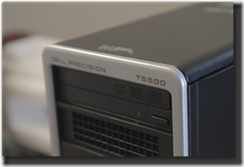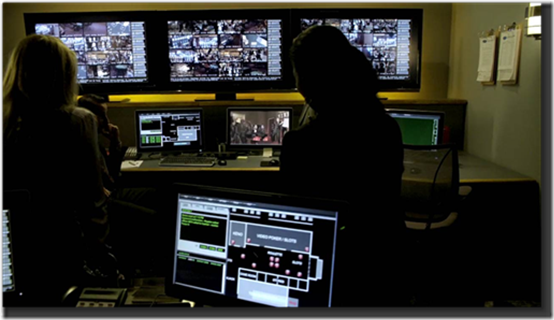Editor’s Note: Scott Hamilton recently blogged about a new series of posts coming from video professional guest bloggers who made the switch from Macs to PCs. This second blog post is from Cory Jamieson. Stay tuned for another guest later this month. Here’s Cory’s post:
At Barnstorm VFX we do visual effects and motion graphics for television and film. We use Adobe products on a daily basis for various projects, mostly working in AfterEffects and Photoshop. For editing, we historically used Final Cut Pro to cut our own sequences or interface with editorial sequences from clients.
Barnstorm’s goals in joining the Dell Precision and NVIDIA video editing advisory program were twofold:
1) With the release of FCP X, we realized that Apple’s focus on consumer-centric apps and iOS might be a risk for us if we continued to rely on them to create and support professional editing products. Avid has dominated the television and film editing markets for decades but its cost and relatively close-ended work environment left us looking at Premiere to fill the hole we felt was coming.
2) Along with this, we felt Apple in general was lagging in its development and support of the Mac Pro line and we were curious to see how a comparable off-the-shelf PC might perform under the conditions we would be working under in production.
We’ve been using the Dell Precision T5500 Workstation for a few months now and I can say with confidence that it is production proven. We’ve certainly put it through its paces using a variety of Creative Suite 6 (CS6) applications and more. We work primarily on broadcast television, with some feature film and commercial work as well. Let’s start by describing the system. Then the workflow and how the workstation performed under various conditions.
Our hardware configuration:
- Dell Precision T5500
- Dual Quad Core Intel Xeon Processor E5620, 2.40GHz
- 1.0GB NVIDIA Quadro 2000
- 6.0GB NVIDIA TESLA C2075
- 48GB, 1333MHz, DDR3 RDIMM, ECC (6 DIMMS)
- 256GB 2.5, Solid State Drive, SATA3
- 1TB SATA 3.0Gb/s with NCQ and 16MB DataBurst Cache
- 1TB SATA 3.0Gb/s with NCQ and 16MB DataBurst Cache
- Dell UltraSharp U2410 24in display
Worthy of note is the sleek form factor. I was personally amazed how much hardware they snuck in there. With such a small footprint, deployment in almost any office environment should be pretty simple. Also, the UltraSharp displays are some of the best on the market (Full disclosure – I personally had one on another workstation before this trial). I haven’t tried any monitors at that price point that have as high a color reproducibility gamut.
The primary system we were comparing it to is an older model (late 2009) Mac Pro:
- Dual Quad 2.66 GHz Xeon Processor
- NVIDIA Quadro 4000 graphics card
- 36 GB RAM
- 120GB SSD boot
- 3 x 1TB internal SATA
Now these two systems obviously aren’t matched up line for line and that really wasn’t the point of our participation in the trial either. Because the two workstations were intended to perform similar tasks, and future purchasing decisions may hinge on it, the idea was simply to see if the T5500 would perform those tasks comparably or better, as the price point on Macs is significantly higher.
So we ran it through its paces on several productions with its primary functions being the following:
- Adobe Applications (CS5.5 and then CS6)
- Premiere – Editing short sequences of vfx material
- After Effects – Compositing VFX shots and motion graphics
- Photoshop – Supporting the above applications as necessary
We also used it for some secondary functions:
- Modeling in zBrush
- Rendering in Lightwave 3D
- Simulation of Smoke and Fire in Turbulence, a plugin for Lightwave
For its primary applications it performed superlatively. The Maximus configuration is basically a plug and play setup in Premiere (just double check your Mercury Playback Engine in preferences). We were working with 1080p content almost exclusively and playback was real-time, all the time. We often had multiple layers of content playing back (sometimes inset, sometimes with blending modes) and even when premiere would put the red line above the timeline (indicating it would have to render out and that real-time playback was unlikely) it never even hiccupped.
An example of how this came in handy was on the television crime drama Body of Proof (new season starting this Fall on ABC). Frequently there is security footage and characters often review it on computer monitors or TV screens to identify suspects (see shot example below). Often this video cannot be played through these devices practically on set. The timing of the video has to be just right, or the action might be dependant on dialogue, or in some cases, the screen content hasn’t been shot yet. So very often these scenes are shot with green screen on the TV or computer and then composited into the shot later.
Shot example – security monitors
In the above shot example, the three large screens contain 16 videos each. In this case they are stock footage of a casino. There were only 3 actual HD source videos of the casino that each ran about 45 seconds. This shot is about 7 seconds long, so each of those three stock clips had to be scaled, repositioned and edited so that it fit inside the screen, covered the timing of the shot and hid any repeated elements in what are now 48 individual videos. This gives a very believable impression of a vast network of security cameras using only 3 discreet video elements.
Because of Premiere’s ability to playback multiple HD streams through the Mercury playback engine in real-time, it was the ideal tool to edit this element together. Usually having 16 streams running simultaneously with scaling and repositioning bogs down the system and you have to render out bits and pieces to preview. But in Premiere it was fast and fluid, enabling quick editing of the onscreen contents, which were then rendered out as a single video that was tracked and composited into the screens in After Effects.
In After Effects there are also many things the T5500 did that fit nicely with our workflow. Especially in CS6, where After Effects benefits from the Global Performance Cache, the 48GB of RAM really allowed for efficient previewing performance. Also, the NVIDIA Maximus configuration again proved extremely fast for the new ray tracer, which we were using for extruded text and motion graphics. This became the go-to workstation for those sequences as everything else in the office was slow by comparison. For final rendering, with 8 cores (16 hyper-threaded), it also did great on multi-core jobs as we could easily allocate 3GBs per core and still be able to run Photoshop on the side without a drop in performance.
This also made it good as a render box for 3D applications, which we would frequently do on overnight renders when no one would be editing or compositing on it.
In our simulation experiments it also performed better (often by as much as 50% time savings) when using the GPU to accelerate fluid sims. As more and more simulation software begins to support GPU acceleration, this will become a bigger and bigger deal. In the near future, very high-end simulations will soon be performed on a box with a few good GPUs that currently require distributed network simulations at much higher cost. Dell and NVIDIA have positioned themselves well for this inevitable shift in the vfx industry.
Our experience working on the advisory program was extremely beneficial. Going back to the Windows platform after so many years on a Mac takes a little getting used to if you haven’t done it in a while. But one thing I found refreshing is how much support there is for Windows applications, and I don’t just mean editing software. Usually on the Mac you have to wait for the “Mac Version” to come out, plugins are Windows only, or in many cases (e.g. 3D Studio Max), the whole application is Windows only. When we’re planning future hardware acquisitions I think it’s a good bet a Dell or two will end up in our pipeline.
——-
Here’s Cory’s bio:
 Cory Jamieson, VFX Producer, Inspire Studios: Cory has a background in editorial and post-production. As Co-owner of a boutique visual effects house, Barnstorm VFX, he continues to develop more efficient integration between post-production and visual effects workflows. Cory began his life in post-production editing and producing featurette content for DVDs, including Cloverfield and Mission Impossible III, among others. He made his way into television, transitioning into visual effects on the series Ugly Betty. He has since worked on such shows as Body of Proof, In Plain Sight and The Big C, to name a few.
Cory Jamieson, VFX Producer, Inspire Studios: Cory has a background in editorial and post-production. As Co-owner of a boutique visual effects house, Barnstorm VFX, he continues to develop more efficient integration between post-production and visual effects workflows. Cory began his life in post-production editing and producing featurette content for DVDs, including Cloverfield and Mission Impossible III, among others. He made his way into television, transitioning into visual effects on the series Ugly Betty. He has since worked on such shows as Body of Proof, In Plain Sight and The Big C, to name a few.

